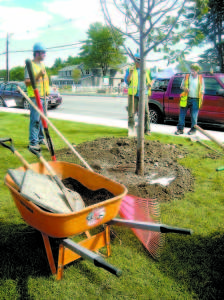Tree plantings community driven

GREAT TIME TO PLANT — Employees from the subcontractor Sabra Property Care, transplant an American Basswood in the green space next to the boardwalk on the Naples Causeway recently. (De Busk Photo)
By Dawn De Busk
Staff Writer
NAPLES — It was an arborist’s dream come true.
Arriving by truck there was a shipment of trees – ready to be transplanted on a sunny, almost windless day in September.
“Fall is absolutely the best time of the year to plant deciduous trees,†said Kent Cooper, the Maine Department of Transportation (MDOT) senior landscape architect.
“I am totally an advocate for fall planting as are many arborists and horticulturalists,†he said.
Cooper — along with members of the Causeway Restoration Committee (CRC) and expert green thumbs — has been involved with the landscaping end of the state-funded three-year project to build the Bay of Naples Bridge and revitalize the Causeway.
This week, Cooper was pumped that everything had fallen into place for the transplanting of trees that had been chosen to grow there by members of the community.
“This was very locally driven,†he said.
Also, CRC Chairman Bob Neault was ecstatic about both the aesthetic appeal and the town-wide pride the trees would provide.
“Seeing the additional landscaping on the Causeway is going to invigorate the community,†Neault said.
Cooper commented that not only did the final project require several months of learning and planning on the part of the committee; but also when the trees rolled into town, business owners walked the Causeway and came to an agreement as to where the trees would look the best.
“Last Friday, people came down and flagged where the trees would go,†he said.
September’s shipment of trees and shrubbery included: American Basswood, Patriots’ Elm, Japanese Lilac (also known as Ivory Silk), Hydrangea bushes, and a variety of Birch and Crabapple.
All of the trees and shrubbery were selected for their ability to survive in the harsh conditions.
While spring is generally associated with the planting season, bulbs and deciduous trees benefit best from autumn planting.
The fall weather is the key to help the leaf-bearing trees and shrubbery take root, according to MDOT’s Cooper.
“These trees are still growing so they are going to make new roots in a couple of weeks in preparation for winter. The trees are going to make roots now,†he said, adding because in the autumn, the soil is at its peak warmth and is abundant with nutrients.
“Then, the trees will be dormant all winter; and, then they will have the opportunity to make some roots again in the spring,†he said.
Therefore, the transplanted trees will have two growing seasons before summertime when the trees are “most challenged by the heat,†he said.
The Patriots’ Elm that was chosen to call Naples its new home is a hybrid designed to be resistant to the Dutch Elm disease that dropped so many of the elm trees that once lined New England streets.
As the landscaping portion of the project lines up nicely, like the trees on the Causeway, residents of this region will have a space to commemorate many occasions.
Sometimes, the trees will simply be the backdrop; and other times, the trees will be the center of attention.
According to Cooper, “We will be planting one big balsam as a Christmas tree.â€
He said the construction was not yet completed to the point that the evergreen could be transplanted this month. While leafy trees like the American Basswood and Patriots’ Elm transplant well in the autumn, evergreens tend to root better in the warmth of spring.
Therefore, that balsam may not become part of the landscape until later. It may be a vision of Christmases to come.
However, as early as this autumn, local residents will see the transplanted trees standing for future generations who visit the Causeway.
Subcontractor Sabra Property Care, Inc. was hired under the MDOT’s prime contractor Wyman and Simpson Inc. to take care of the trees.
Also, the locally-based company, Thirsty Turf, set up the sprinkler system this spring.
“Since we have irrigation here everything will be fine,†MDOT’s Cooper said.
Spigots have been hooked to each tree to provide the adequate amount of water for the first year or two of the growth cycle.
“It’s great to see the trees coming up. We will probably do more flower beds in the spring,†CRC Chairman Neault said.

